Centauri Dreams
Imagining and Planning Interstellar Exploration
The Odds on Intelligent Life in the Universe
If we could somehow rewind time to the earliest days of the Solar System and start over again, would life — and intelligence — reappear? It’s an experiment science fiction authors are able to try, but it defies real world science. Nonetheless, we can make approaches to the problem through the analysis of probabilities. In particular, we can use statistics, and the technique known as Bayesian inference, which weighs probabilities updated by new evidence.
This is a helpful exercise given that so often I hear people referring to the idea that intelligent life must be everywhere because the universe is so vast and there are so many opportunities for it to arise. But does life inevitably emerge on what we might consider habitable worlds?
What if this process of abiogenesis is rare? The question points to the fact that we have absolutely no idea what the likelihood is, and therefore assumptions about intelligent life based solely on numerical opportunity are nothing but speculations.

Enter Columbia University’s David Kipping, whose work has been featured often in these pages. Kipping tackles the question of the likelihood of life and the development of intelligence in a new paper in Proceedings of the National Academy of Sciences. He has a chronology to work with, one involving life’s earliest appearance as found in fossils, the emergence of humans, and the habitability constraints of our planet’s surface conditions, using it to draw inferences on how quickly life can arise, and how unusual intelligence may be.
The scenarios — derived as what in Bayesian terms are called ‘objective priors’ — are relatively straightforward, each of them worth examining in light of the fact that we have no observational evidence for life beyond the Earth. Our planet is our data point, and with all the disadvantages that produces, we can still draw inferences about life elsewhere from the constraints we can establish here. We know that abiogenesis is possible because we are here to write about it. But Kipping applies statistical methods based on Bayesian mathematics to consider the odds.
The first scenario (and the one I favor): Life is common, but rarely develops intelligence. I suspect we’re going to find evidence for simple life all over the Orion Arm as we extend our technologies outward, but little evidence for technologies. But other scenarios exist: Life is common and so is intelligence. And perhaps abiogenesis is rare. In that case, we may find life unusual but intelligence a common consequence when it does happen. Finally, life may be as rare as intelligence.

Image: Are we alone in the universe? A new study uses Bayesian statistics to weigh the likelihood of life and intelligence beyond our solar system. Credit: Shutterstock/Amanda Carden.
Which scenario to choose? Bayesian techniques involve testing a position against new evidence that can be applied to the question, which allows estimates to get better as they are refined. Bayesian mathematical formulae tackle how to model one scenario against another. And I found the result Kipping arrived at encouraging. Let me quote him on the matter:
“In Bayesian inference, prior probability distributions always need to be selected. But a key result here is that when one compares the rare-life versus common-life scenarios, the common-life scenario is always at least nine times more likely than the rare one.”
Drawing on our single data point — Earth — Kipping points out that we know life emerged quickly. We have to factor in the impact with the Mars-sized “Theia” some 4.51 billion years ago (leading to the formation of the Moon), but mineralogical evidence from zircons points to an atmosphere and liquid water present on Earth’s surface by roughly 4.4 billion years ago. The earliest evidence for life is found in 4.1 billion year old zircon deposits in the form of depleted carbon inclusions, a controversial datapoint, but undisputed evidence for life turns up in microfossils found in 3.465 billion year old rocks in western Australia.
We can come up, then, with the length of time for which Earth is expected to persist as habitable for intelligent beings, factoring in the growing luminosity of the Sun and the increased rate of weathering of silicate rocks on Earth and eventual depletion of carbon dioxide in the atmosphere. Kipping arrives at a habitable ‘window’ of 5.304 billion years. That’s from the beginning of life to its likely end, and it shows how significant is the question of how fast abiogenesis happens. If it takes too long, life would never emerge under the conditions most planets would face as their star continued to evolve. 900 million years from now, Earth will be a hostile place indeed.
But back to the key result — and I have to send the reader to the paper for the complex Bayesian mathematics involved — Kipping draws on a 2012 paper from Spiegel and Turner to refine the Bayesian formalism produced there for interpreting life’s early emergence on Earth. He considers it against the broader context of the habitable ‘window.’ From the Kipping paper:
The early emergence of life on Earth is naively interpreted as meaning that if we reran the tape, life would generally reappear quickly. But if the timescale for intelligence is long, then a quick start to life is simply a necessary byproduct of our existence—not evidence for a general rapid abiogenesis rate. Using our objective Bayesian framework, we show that the Bayes factor between a fast versus a slow abiogenesis scenario is at least a factor of 3—irrespective of the prior or the timescale for intelligence evolution. This factor is boosted to 9 when we replace the earliest microfossil evidence… with the more disputed 13C-depleted zircon deposits…
Thus the common life scenario gains odds, and markedly so. As for intelligence, Kipping’s analysis precludes the possibility that it emerges quickly (in less than billions of years), while the idea that intelligence is rare remains viable. Even so, he finds betting odds of only 3:2 that intelligence rarely emerges — this slight preference for rare intelligence is consistent with our lack of SETI results but leaves the question of searching for intelligence elsewhere wide open. Life is likely to emerge on other worlds, in other words, but our one data point — Earth — tells us that intelligence emerges only with time and difficulty. We have no outstanding way to choose here one way or another. Let me quote from the paper on this:
…our work supports an optimistic outlook for future searches for biosignatures…The slight preference for a rare intelligence scenario is consistent with a straightforward resolution to the Fermi paradox. However, our work says nothing about the lifetime of civilizations, and indeed the weight of evidence in favor of this scenario is sufficiently weak that searches for technosignatures should certainly be a component in observational campaigns seeking to resolve this grand mystery.
Life commonly found, the prevalence of intelligence still a mystery. Keep looking, but you now have some insight into where to place your chips in your next trip to the astrobiological casino.
If you’re interested in learning about Bayesian inference and the surprising successes of Bayesian analysis, I recommend Sharon McGrayne’s book The Theory That Would Not Die: How Bayes’ Rule Cracked the Enigma Code, Hunted Down Russian Submarines, and Emerged Triumphant from Two Centuries of Controversy (Yale University Press, 2011) as an excellent backgrounder.
The paper is Kipping, “An objective Bayesian analysis of life’s early start and our late arrival,” Proceedings of the National Academy of Sciences 18 May 2020 (full text). You can see Kipping’s lively video presentation on this work at https://www.youtube.com/watch?v=iLbbpRYRW5Y.

TRAPPIST-1: Orbital Alignment Among Rocky Worlds
You would think that the orbits of planets would align closely with the spin of their star, since they emerged from the same primordial disk. Many planets do just that, and in our own system, the orbits of the planets are aligned within 6 degrees of the Sun’s rotation. But the numerous cases of star-planet orbital misalignment around other stars cause us to question whether these systems formed out of alignment or were influenced by later perturbations. A massive companion in a wide orbit could do the trick, and other mechanisms to tilt the orbital or spin axes are discussed in the literature.
To examine the question, the Rossiter-McLaughlin effect comes into play. Discovered by studying binary stars, the effect is named after the two University of Michigan graduate students who figured it out back in the 1920s. They realized that as a star rotates, part of it seems to be coming toward the observer, creating a blueshift, while the other side seems to be moving away, producing a redshift. As a transiting planet blocks part of the background stellar disk, it creates an observable effect in the redshift that flags the direction of the planet’s rotation.
Thus we tease out yet further information about planets we cannot directly see. Now a team of astronomers using the Subaru Telescope has been able to deploy the Rossiter-McLaughlin effect to measure the obliquity, or spin-orbit angle, of three of the planets in the intriguing TRAPPIST-1 system. Here we have an M-dwarf orbited by seven small planets, evidently rocky, with three in or near the habitable zone as defined by the possibility of liquid water on the surface.
What we learn is that the three transiting planets the team observed on August 31, 2018 (two of them near the habitable zone) have an obliquity that is near zero. This marks the first time that stellar obliquity has been measured in a system around a very low-mass star like TRAPPIST-1. Led by Teruyuki Hirano (Tokyo Institute of Technology), the astronomers used the InfraRed Doppler (IRD) spectrograph, a new instrument on the Subaru Telescope, to make the measurement. Says Hirano:
“The data suggest alignment of the stellar spin with the planetary orbital axes, but the precision of the measurements was not good enough to completely rule out a small spin-orbit misalignment. Nonetheless, this is the first detection of the effect with Earth-like planets and more work will better characterize this remarkable exoplanet system.”
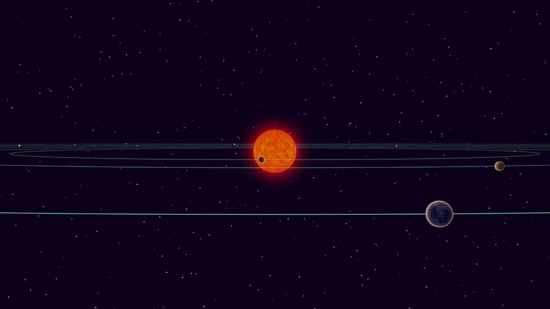
Image: Artist’s impression of the TRAPPIST-1 exoplanet system.(Credit: NAOJ).
Learning about spin-orbit misalignment (or the lack of same) is useful as we try to understand how planets around low mass stars evolve. The lack of larger worlds around this star, or the presence of a nearby star, means that the planetary orbits here are probably located close to where the planets first formed, so the orbits offer a window into the early days of the system. Rossiter-McLaughlin analyses have hitherto been restricted to planets of at least Neptune mass, so we’re pushing into new territory as we take advantage of IRD’s high spectral resolution.
Assuming the orbits of the TRAPPIST-1 system are coplanar, the authors offer their take on the system’s evolution:
Our result supports the idea that the known planets in the TRAPPIST-1 system achieved their compact configuration through convergent migration, and did not experience any substantial misaligning torques from processes such as planet-planet scatterings or long-term gravitational perturbations from a massive outer companion on an inclined orbit. It is unlikely that any primordial obliquity has been erased by tidal realignment between the star and these low-mass planets.
And on that assumption of a coplanar system, the authors add that they were unable to test it by measuring the mutual inclinations between the planets:
The mutual inclinations might be measurable in the future using repeated observations of Doppler transits to give a higher S/N. The mutual inclination between two planetary orbits might also be measured by observing the photometric effect of a planet-planet eclipse during a double transit event (Hirano et al. 2012). This would be another important clue to understand the architecture and dynamical history of the TRAPPIST-1 system.
No equivalent studies have been performed on a star this small, but the window is clearly opening on methods for studying the orbital architectures of such planetary systems.
The paper is Hirano et al., “Evidence for Spin-Orbit Alignment in the TRAPPIST-1 System,” Astrophysical Journal Letters Vol. 890, No. 2 (25 February 2020). Abstract.

More Evidence for Plumes on Europa
Were deviations in Jupiter’s magnetic field, recorded by Galileo’s magnetometer during a flyby of Europa in 2000, an indication of a cryovolcanic eruption? The data on this event have been evaluated by several independent groups in Europe and the US, an indication of how much interest such a plume would generate. If, like Enceladus, Europa occasionally blows off material from below the surface, we would have the possibility of collecting water from its ocean without having to drill through kilometers of ice.
Now a team of European Space Agency scientists led by Hans Huybrighs, working with colleagues at the Max Planck Institute for Solar System Research (MPS), has gone to work on the question, this time through the measurements made by Galileo’s Energetic Particles Detector (EPD), an instrument with roots both at MPS and the Applied Physics Laboratory of Johns Hopkins University (APL). EPD recorded significantly fewer fast-moving protons near Europa than expected during the same flyby. This adds weight to the conclusions of those finding evidence for a plume in the magnetometer data.
Jupiter’s magnetic field is twenty times stronger than Earth’s, extending far enough into space that Europa orbits within it. What Huybrighs and company set out to do was to simulate conditions during the flyby, modeling high-energy proton movements that correspond with what the EPD recorded.
The question raised by the EPD instrument is why these energetic protons were disappearing during the E26 flyby, an observation earlier considered to be caused by Europa itself obscuring the detector, making the measurement unreliable. But the paper makes the case that some of the proton depletion could only be explained by a plume of water vapor that disrupted Europa’s tenuous atmosphere and perturbed magnetic fields in the region. Indeed, the simulations are only successful under the assumption of a plume, whose effects are added into those caused by the atmosphere. Evidence for a plume noted by earlier researchers is thus strengthened by an analysis drawn from an independent dataset.
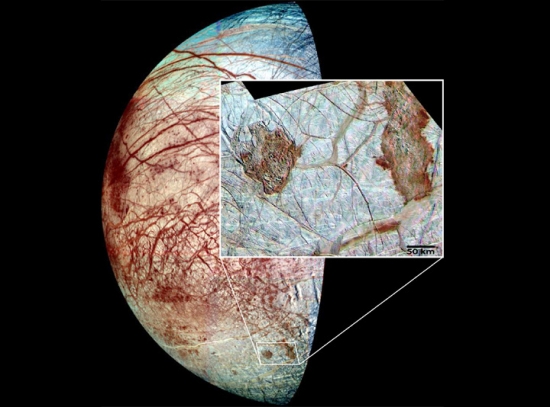
Image: Color image data from the Galileo mission recorded between 1995 and 1998 were used to create this depiction of Europa’s cracked and icy surface. The inset shows dark reddish, disrupted regions dubbed Thera and Thrace. Credit: Galileo Project, Univ. Arizona, JPL, NASA.
The authors’ conclusion also highlights how much we do not know about the environment at Europa, while pointing to a helpful tool for planning purposes on future missions:
Large uncertainties remain in the properties (density profile, 3D structure, temporal variability…) of Europa’s tenuous atmosphere and plumes (Plainaki et al., 2018). This study emphasizes that energetic ions are an important tool that can contribute to the detection and characterization of Europa’s tenuous atmosphere and plumes and probe its moon-magnetosphere interaction, independently of other methods. This is in particular relevant for the upcoming JUICE mission (Grasset et al., 2013), which has the instrumentation to detect both energetic ions and ENAs, using the Particle Environment Package (PEP)…
The ability of JUICE to detect energetic charged and neutral particles near Europa will help us spot future plumes. Note this ESA description of the Particle Environment Package:
A plasma package with sensors to characterise the plasma environment in the Jovian system.
PEP will measure density and fluxes of positive and negative ions, electrons, exospheric neutral gas, thermal plasma and energetic neutral atoms in the energy range from <0.001 eV to >1 MeV with full angular coverage. The composition of the moons’ exospheres will be measured with a resolving power of more than 1000.
For more on the science payload of this mission, with 10 instruments onboard, click here. JUICE launches in 2022 in a mission aimed at Europa, Callisto and eventual orbit at Ganymede.
The paper is Huybrighs et al., “An active plume eruption on Europa during Galileo flyby E26 as indicated by energetic proton depletions,” Geophysical Research Letters 12 May 2020 (abstract).

Ryugu: An Asteroid’s Interactions with the Sun
The near-Earth asteroid Ryugu is only about a kilometer wide, but it’s telling us a good deal about its own history and that of the Solar System itself thanks to the two touchdowns of Hayabusa2, in February and July of 2019. The geological changes so clear on Earth, the bombardments from objects creating craters here and elsewhere, all mark the evolution of large bodies, but the asteroids take us back to the system’s earliest days with little change. They’re bundles out of the deep freeze of time.
Now we wait for the sample return, currently on its way back to Earth, with arrival in December of this year. Aboard will be surface materials collected during both touchdowns, which will complement the data on the chemical and physical composition of the asteroid already gathered. A team led by Tomokatsu Morota (University of Tokyo) has been using Hayabusa2’s onboard ONC-W1 and ONC-T imaging instruments to analyze the dusty matter kicked up by the spacecraft’s engines during the two touchdowns.
Fine grains of dark-red colored minerals turned up in this analysis. The team believes these were produced by solar heating, indicating close passage by the Sun at some point in Ryugu’s past. This view is reinforced by the distribution of the dark red-matter. Spectral examination shows the material can be found at specific latitudes on the asteroid, corresponding to areas that would have received the most solar radiation in the asteroid’s past. Adds Morota:
“From previous studies we know Ryugu is carbon-rich and contains hydrated minerals and organic molecules. We wanted to know how solar heating chemically changed these molecules. Our theories about solar heating could change what we know of orbital dynamics of asteroids in the solar system. This in turn alters our knowledge of broader solar system history, including factors that may have affected the early Earth.”
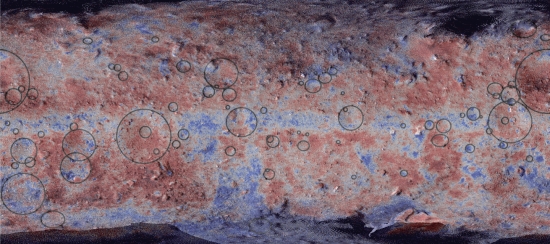
Image: False color map of the surface of Ryugu with craters marked by circles. Credit: © 2020 Morota et al.
The distribution of surface materials suggests a history of disruption by impacts and what the paper describes as thermal fatigue and mass wasting. Let me quote from this section:
The thickness of the mixed layer of redder and bluer materials is estimated to be a few meters, derived from the minimum crater size (~10 m in diameter) that penetrates to the underlying blue materials. The presence of ejecta rays with a length of a few tens of meters that consist primarily of redder materials implies that the redder material layer originally had a minimum thickness of a few tens of centimeters. Solar heating is more likely than space weathering to be the source of the reddening of Ryugu’s surface, because space weathering typically affects only a thin layer of ~100 nm, whereas the diurnal and annual thermal skin depths (the depth at which temperature variations decay to 1/e of their value at the surface) are ≲10 cm and ~1.5 m, respectively.
It’s encouraging to hear from Morota’s group that their spectral studies and examination of Ryugu’s albedo indicate that both the dark-red material once heated by the Sun as well as blue unheated materials would have been collected in Hayabusa2’s two forays to the surface. Also on the agenda in coming months is a close look at the distribution of Ryugu’s craters and boulders. The surface craters hold information about the characteristics of the asteroid’s rocks and the history of small impacts. They also greatly complicated the search for a safe landing site.
What produced the differences between the two types of materials remains unclear:
Two distinct types of material are present on the surface with different colors: bluer material distributed at the equatorial ridge and in the polar regions and redder material in the mid-latitude regions. However, the cause of these spectral variations is not understood.
The paper is Morota et al., “Sample collection from asteroid (162173) Ryugu by Hayabusa2: Implications for surface evolution,” Science Vol. 368, Issue 6491 (8 May 2020), pp. 654-659 (abstract).

The Closest Black Hole to Earth
Black holes are such exotic objects that they somehow suggest great distance. We’re learning about the black holes at the center of many galaxies even as we’re just beginning to catalog the location of smaller ones elsewhere. But we’re also learning through gravitational wave studies about their interactions and have begun to find black holes closer to home. Thus the just announced discovery of a black hole 1,000 light years from Earth. A long way, to be sure, but the closest ever found to our planet.
Evidence for the object comes from the MPG/ESO 2.2-metre telescope at ESO’s La Silla Observatory in Chile, deduced by a team of astronomers led by Thomas Rivinius from observations of two companion stars. This is, in other words, a triple system, and one that can be seen with the naked eye at that. The system is located in Telescopium, its stars viewable without binoculars or telescope on a clear southern hemisphere night. In fact, here’s where to look.
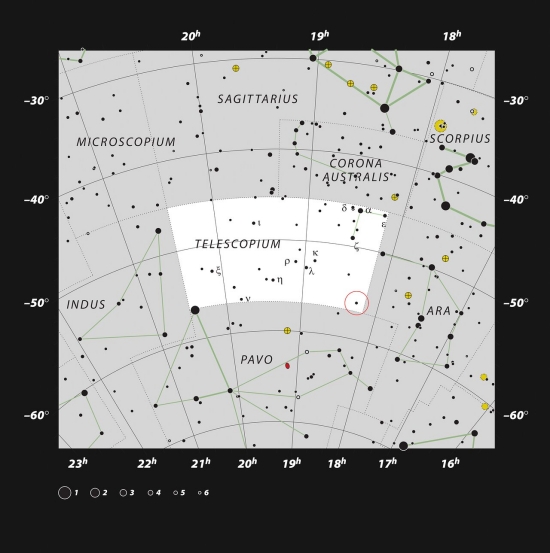
Image: This chart shows the location of the HR 6819 triple system, which includes the closest black hole to Earth, in the constellation of Telescopium. This map shows most of the stars visible to the unaided eye under good conditions and the system itself is marked with a red circle. While the black hole is invisible, the two stars in HR 6819 can be viewed from the southern hemisphere on a dark, clear night without binoculars or a telescope. Credit: ESO, IAU and Sky & Telescope.
The system is HR 6819, which was under study by the Rivinius team as part of an effort targeting double-star systems. It took the FEROS spectrograph on the La Silla instrument to show that one of the two visible stars orbits an unseen object every 40 days. The other star is at a large distance from the inner star/black hole pairing.
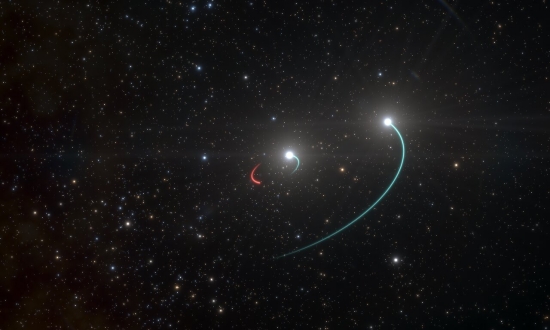
Image: This artist’s impression shows the orbits of the objects in the HR 6819 triple system. This system is made up of an inner binary with one star (orbit in blue) and a newly discovered black hole (orbit in red), as well as a third star in a wider orbit (also in blue). The team originally believed there were only two objects, the two stars, in the system. However, as they analysed their observations, they were stunned when they revealed a third, previously undiscovered body in HR 6819: a black hole, the closest ever found to Earth. The black hole is invisible, but it makes its presence known by its gravitational pull, which forces the luminous inner star into an orbit. The objects in this inner pair have roughly the same mass and circular orbits. The observations, with the FEROS spectrograph on the 2.2-metre telescope at ESO’s La Silla, showed that the inner visible star orbits the black hole every 40 days, while the second star is at a large distance from this inner pair. Credit: ESO/L. Calçada.
We are dealing with a stellar-mass black hole that shows no visible interactions with its environment, and thus had to be deduced from the orbit of the nearby star. As lead author Rivinius notes: “An invisible object with a mass at least 4 times that of the Sun can only be a black hole.” A reasonable conclusion, and a black hole that stands in contrast to the black holes previously discovered in the galaxy, nearly all of which are detectable through strong X-ray emissions as they affect nearby matter.
If we’ve found a black hole this comparatively close to the Solar System, what does this say about their numbers elsewhere? Rivinius speaks in terms of hundreds of millions of black holes, considering how many stars have ended their existence through gravitational collapse into such objects over the lifetime of the galaxy. Marianne Heida (ESO), a co-author of the paper, points to signs of another such system:
“We realised that another system, called LB-1, may also be such a triple, though we’d need more observations to say for sure. LB-1 is a bit further away from Earth but still pretty close in astronomical terms, so that means that probably many more of these systems exist. By finding and studying them we can learn a lot about the formation and evolution of those rare stars that begin their lives with more than about 8 times the mass of the Sun and end them in a supernova explosion that leaves behind a black hole.”
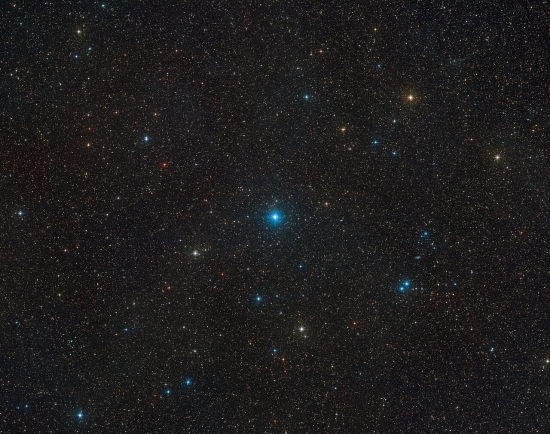
Image: This wide-field view shows the region of the sky, in the constellation of Telescopium, where HR 6819 can be found, a triple system consisting of two stars and the closest black hole to Earth ever found. This view was created from images forming part of the Digitized Sky Survey 2. Credit: ESO/Digitized Sky Survey 2. Acknowledgement: Davide De Martin.
We may also gain insights into the cosmic mergers that gravitational wave astronomy has shown us by studying systems like HR 6819. In such cases, we may be dealing with systems where the inner pairing is made up of two black holes, or a black hole and a neutron star. In that scenario, the outer star in the triple system could interact gravitationally so as to cause a merger that releases gravitational waves.
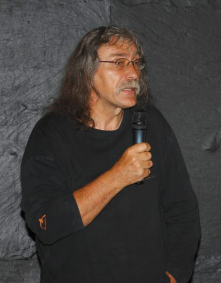
Before ending today’s article, I want to mention that the Rivinius paper is dedicated to the memory of the Czech astronomer Stanislav (Stan) Štefl, who died recently at age 58 in a car accident in Santiago, Chile. A tribute can be found here. Dr. Štefl worked at ESO Headquarters as a research associate and, from 2004 until 2012, was a Very Large Telescope Interferometer (VLTI) support astronomer at Paranal Observatory. For the past year and a half, he had been on assignment to the Atacama Large Millimeter/ submillimeter Array (ALMA), working in Santiago and at Chajnantor.
Although we discuss objects and distances at scales that defy the imagination, our community is a relatively small one. Such losses are wounds for us all.
The paper is Rivinius et al., “A naked-eye triple system with a non-accreting black hole in the inner binary,” Astronomy & Astrophysics Vol. 637, L3 (May, 2020). Abstract.

Polarimetry Probes Brown Dwarf Clouds
It will surprise few Centauri Dreams readers that at least some brown dwarfs have bands of clouds, just as we see similar bands on our Solar System’s largest planet. In fact, three brown dwarfs have recently shown signs of cloud banding, and today’s subject, Luhman 16, has previously been analyzed in terms of large cloud patches. I think new work based on data from the European Southern Observatory’s Very Large Telescope (VLT) in Chile may be less significant for what it says about brown dwarfs than what it says about how we study them.
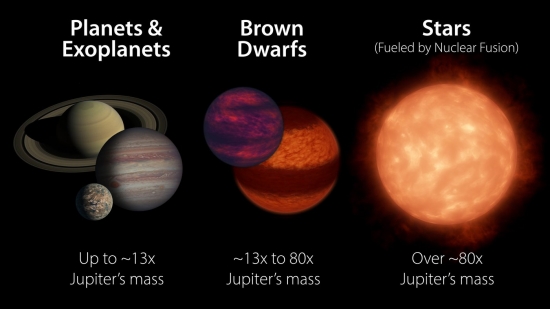
Image: Illustration comparing the masses of planets, brown dwarfs, and stars. Credit: NASA/JPL-Caltech/R. Hurt (IPAC).
For the work in question, reported in a paper from Maxwell Millar-Blanchaer (Caltech) and colleagues, is the first time polarimetry has been put to work to infer bands in brown dwarf clouds. Polarization tells us the direction that a light wave oscillates. Millar-Blanchaer likens polarimetric instruments to polarized sunglasses — here, one direction of polarization is blocked to reduce glare — but adds that astronomers are less concerned with reducing glare than measuring it. Light reflecting off cloud droplets can favor a measurable angle of polarization.
We’re beginning to see methods to analyze polarized light cropping up more and more in astronomy, with implications for exoplanets. Thus Dimitri Mawet (Caltech), a senior research scientist at the Jet Propulsion Laboratory:
“Polarimetry is receiving renewed attention in astronomy. Polarimetry is a very difficult art, but new techniques and data analysis methods make it more precise and sensitive than ever before, enabling groundbreaking studies on everything from distant supermassive black holes, newborn and dying stars, brown dwarfs, and exoplanets, all the way down to objects in our own solar system.”
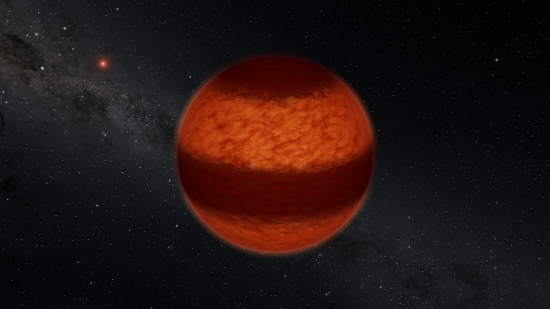
Image: Astronomers have found evidence for a striped pattern of clouds on the brown dwarf called Luhman 16A, as illustrated here in this artist’s concept. The bands of clouds were inferred using a technique called polarimetry, in which polarized light is measured from an astrophysical object much like polarized sunglasses are used to block out glare. This is the first time that polarimetry has been used to measure cloud patterns on a brown dwarf. The red object in the background is Luhman 16B, the partner brown dwarf to Luhman 16A. Together, this pair is the closest brown dwarf system to Earth at 6.5 light-years away. Credit: Caltech/R. Hurt (IPAC).
Luhman 16 draws attention for being the closest known brown dwarf binary, approximately 6.5 light years away. Both brown dwarfs weigh in at roughly 30 times Jupiter’s mass, examples of ‘failed stars’ that formed from collapsing clouds of gas but lacked the mass to ignite hydrogen fusion. Millar-Blanchaer and team used the VLT’s NaCo instrument (Nasmyth Adaptive Optics System, coupled with the Near-Infrared Imager and Spectrograph called CONICA) to study the polarized light from both of the Luhman brown dwarfs. Luhman 16A’s polarization can only be explained by bands of clouds, while the data on bands are inconclusive for Luhman 16B. The latter’s variability in brightness seems to be the result of irregular, patchy clouds instead.
Consider what we’re doing here. It took NASA’s Wide-field Infrared Survey Explorer (WISE) to find Luhman 16 in 2013, and Millar-Blanchaer’s team now detects clouds through polarization that cannot be directly resolved. The scientists used atmospheric modeling run against measurements of the polarized light to infer the presence of the cloud bands on Luhman 16A.
“To determine what the light encountered on its way we compared observations against models with different properties: brown dwarf atmospheres with solid cloud decks, striped cloud bands, and even brown dwarfs that are oblate due to their fast rotation. We found that only models of atmospheres with cloud bands could match our observations of Luhman 16A,” says Theodora Karalidi (University of Central Florida), a member of the discovery team.
The beauty of using polarimetry this way is that it is sensitive to cloud properties, a trait that should serve us well not only with brown dwarf atmospheres but those of exoplanets. A follow-up study is on the way that will examine later observations looking for short- and long-term variability in the polarization. Meanwhile, the current work confirms the existence of banded clouds near the L/T transition in brown dwarfs, an evolution in spectral type that ultimately results in relatively cloud-free regions across the brown dwarf disks. The previously studied cloud bands have all been in similar L/T transition dwarfs. From the paper:
We have demonstrated that polarimetry provides a promising avenue to answer this question; variability occurrence rates and amplitudes decline outside of the L/T transition, and therefore many targets are unsuitable to cloud mapping via variability monitoring. High-accuracy targeted polarimetric studies sensitive to cloud bands similar to those found in this study may therefore be critical to furthering our understanding of the cloud dynamics in substellar objects. The characterization presented herein relies heavily on previous characterization of Luhman 16. Similar polarimetric studies should be pursued for other brown dwarfs with comparable levels of characterization (e.g., brown dwarfs with well-constrained masses and/or inclinations).
So we have a path forward in studying brown dwarf atmospheres and, potentially, the atmospheres of giant exoplanets. Follow-up work on Luhman 16’s two brown dwarfs is complicated by the fact that the NaCo instrument package has just been decommissioned , but other near-infrared polarimeters are out there, and we should anticipate new atmospheric studies growing out of the data they collect. Bear in mind that the WFIRST mission will be able to conduct polarimetry, which may be its first application using reflected light to study giant exoplanet atmospheres.
The paper is Millar-Blanchaer et al., “Detection of Polarization due to Cloud Bands in the Nearby Luhman 16 Brown Dwarf Binary,” Astrophysical Journal Vol. 894, No. 1 (5 May 2020). Abstract.


